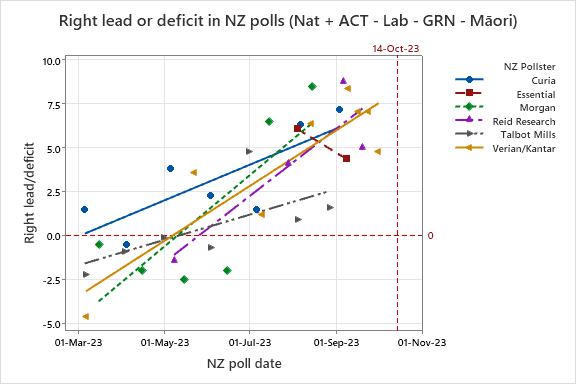9:57am Sunday With all election night votes counted, National won 76.9% in the by-election with NZ First a very distant second on 15.2%. Animal Justice was fourth with 1.6%.
5:31pm This is likely to be my last article for the year for this site. I will see you next year when the US presidential primaries start in January.
5:15pm Over 6,800 votes have been counted in Port Waikato, and National has over 5,400 or 80%. So this one’s over already. Of the 123 total seats, National will hold 49, and there will be 34 Labour, 15 Greens, 11 ACT, eight NZ First and six Māori. So National and ACT add to 60 seats, two short of the 62 needed for a majority.
Guest post by Adrian Beaumont, who joins us from time to time to provide commentary on elections internationally. Adrian is a paid election analyst for The Conversation. His work for The Conversation can be found here, and his own website is here.
Polls close at 5pm AEDT today for a New Zealand by-election in Port Waikato. A candidate’s death after nominations closed caused the postponement of the Port Waikato election from the October 14 general election. National held this seat at the 2020 Labour landslide, so they are expected to easily win the by-election. National’s only significant opposition will come from NZ First, as none of Labour, the Greens or ACT are contesting.
The winner of this by-election will be seated in addition to the 122 elected on October 14. The October 14 results were 48 National, 34 Labour, 15 Greens, 11 ACT, eight NZ First and six Māori. National and ACT combined had 59 seats, short of the 62 needed for a majority. A National win in the by-election would still leave these two parties two short of a majority. So National needed NZ First as well as ACT to form a government. On Friday, three weeks after election results were finalised, these three parties agreed to form a governing coalition.
For the general election, recounts were conducted in three seats, with the winning candidates unchanged. The most important recount was in a Māori-roll seat, which the Māori party had won by four votes over Labour. On the recount, they extended their winning margin to 42 votes. The overall results of the October 14 election were unchanged, with Māori winning six electorate seats, causing a two-seat “overhang” (as there are 122 total seats, not the normal 120).
Far-right party wins most seats at Dutch election
The 150 members of the Dutch lower house are elected by national proportional representation without a threshold. Wednesday’s election was held over a year early owing to a collapse in the previous governing coalition that was led by the conservative VVD.
The far-right Party for Freedom (PVV) won 37 of the 150 seats (up 20 since the March 2021 election), an alliance between Labour and the Greens 25 seats (up eight), the VVD 24 (down ten), the socially left but anti-immigrant NSC 20 (new), the centrist D66 nine (down 15), the agrarian BBB seven (up six), the Christian Democrats (CDA) five (down ten) and the Socialists five (down four). D66 and the CDA were part of the last government.
While the PVV easily won the most seats, they have under half the requirement for a majority (76 seats). They are not at all guaranteed to be part of the next Dutch government. It took ten months after the 2021 election to get a new government. This is the first time the PVV has won the most seats. There was a surge to the PVV in late polling, but polls still understated them.
Poland, the US, Switzerland and Israel
Polish President Andrzej Duda is aligned with the Law and Justice (PiS) party. He was re-elected in 2020 for a five-year term in a runoff by a 51.0-49.0 margin. By initially selecting the PiS parliamentary leader as PM-designate, Duda delayed the formation of a non-PiS government until early December following the October 15 parliamentary election that PiS lost. Polish presidents can veto legislation, and it requires a 60% majority to override this veto, which the parties opposed to PiS don’t have.
A US by-election occurred last Tuesday in Utah’s second federal House seat. With 83% counted, a Republican held by a 56.9-33.9 margin over a Democrat. In 2020, Donald Trump beat Joe Biden in this seat by a 56.7-39.5 margin. The previous Republican member won by 59.7-34.0 in 2022.
I previously covered the October 22 Swiss election, in which the right-wing SVP gained nine lower house seats at the expense of the Greens and Green Liberals. After November runoffs, results for the malapportioned upper house are 15 of 46 seats for the conservative Centre (up two since 2019), 11 Liberals (down one), nine Social Democrats (steady), six SVP (steady), three Greens (down two) and one Green Liberal (up one).
Since the current war began, support for Israel’s right-wing government has crashed into the low-40s out of 120 Knesset seats, down from the mid-50s before the war and 64 seats at the 2022 election. But the next election isn’t due until late 2026.
